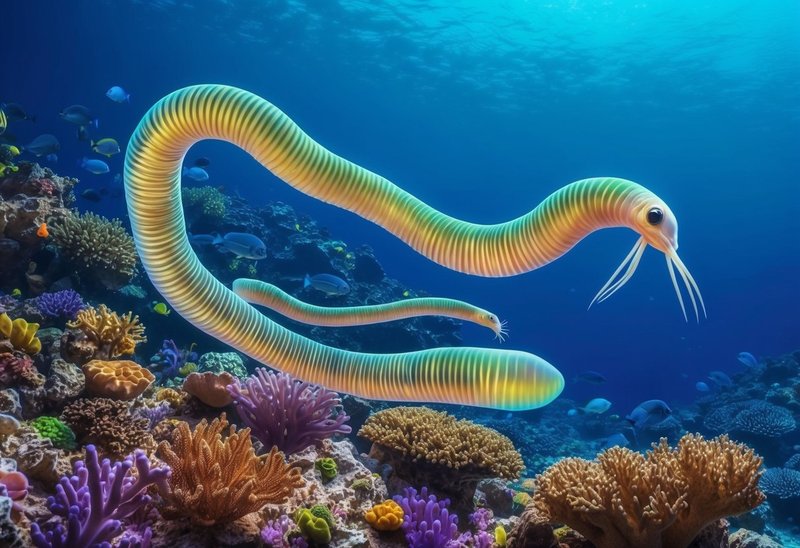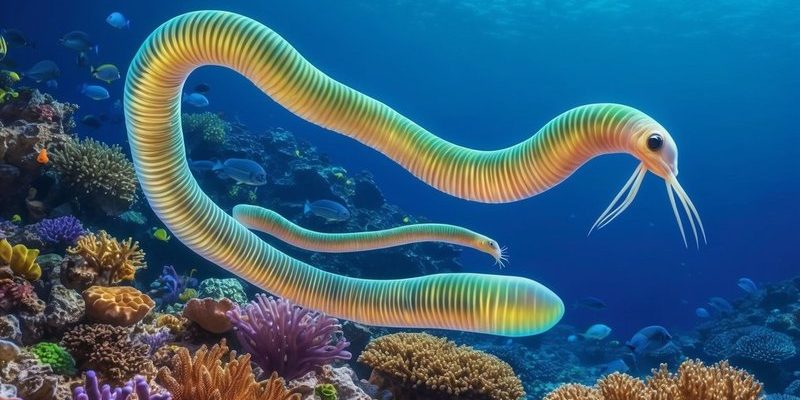
Imagine standing on a beach, the cool waves tickling your toes. Just beneath the surface, a hidden society of creatures is thriving. Bobbit worms can reach lengths of up to 10 feet and are known for their remarkable hunting skills and vibrant colors. Despite their intimidating appearance, they are vital participants in their ecosystems. So, why should we care about these long, segmented worms? Here’s the thing: they have a significant impact on their environment, from influencing food webs to maintaining sediment structure.
What Are Bobbit Worms?
Bobbit worms, scientifically known as *Eunice aphroditois*, belong to a group of marine animals called polychaetes. These worms are named after the infamous Lorena Bobbitt due to their surprising and aggressive hunting methods. They have a long, segmented body with a head that displays impressive jaws. This worm is not just a pretty face; it plays multiple roles in its habitat.
Typically, bobbit worms are found in sandy or muddy substrates along coastlines around the world. They camouflage themselves in their burrows, waiting for unsuspecting prey to come within reach. When dinner arrives, they strike with lightning speed, using their powerful jaws to capture fish, crustaceans, and other small marine creatures. It’s like witnessing a true underwater predator in action!
These worms can live for several years, and during that time, they contribute significantly to the dynamics of their environment. Next, let’s explore their ecological roles.
Bobbit Worms and the Food Web
You might be wondering how bobbit worms fit into the food web of coastal ecosystems. Well, it’s quite simple: they’re both predators and prey. Bobbit worms primarily feed on fish and other small marine organisms, but they also become food for larger predators. This dual role helps maintain a healthy balance within the ecosystem.
As predators, bobbit worms help control the populations of smaller fish and crustaceans. If their numbers were to grow unchecked, these little creatures could deplete the resources in their environment, leading to cascading effects throughout the food web. For instance, if small fish populations decline, larger fish and marine mammals that rely on them for food would also be affected.
Simultaneously, bobbit worms serve as a food source for various animals, including larger fish and even sea turtles. In this way, they contribute to the **biodiversity** of coastal habitats. It’s a classic example of how interconnected everything is in nature.
Impact on Sediment Structure
Bobbit worms also play a significant role in shaping sediment structure in coastal environments. Their burrowing activities help aerate the sand, which is crucial for the health of the marine ecosystem. By creating channels and tunnels, they allow water and nutrients to flow through the sediment more easily.
This aeration process is essential for other organisms, like **bivalves** and **microorganisms**, that rely on oxygen and nutrients in the sand. Without sufficient aeration, these organisms would struggle to survive, leading to a decline in overall ecosystem health. So, when you think about the bobbit worm, consider it a hidden architect of the seafloor!
Moreover, their burrowing can reduce sedimentation rates, which can be beneficial for coral reefs nearby. Too much sediment can smother corals, blocking sunlight and limiting their growth. Bobbit worms, through their actions, help protect these vital marine structures.
Bobbit Worms and Nutrient Cycling
Nutrient cycling is a fancy term for how nutrients move and get reused in ecosystems. Bobbit worms contribute to this process by breaking down organic material in the sediment, which releases nutrients back into the water. These nutrients are essential for phytoplankton and other primary producers that form the basis of the marine food web.
When bobbit worms consume organic material, they help recycle nutrients, making them available for other organisms. This process can enhance productivity in coastal ecosystems, benefiting everything from tiny algae to larger fish. In essence, bobbit worms are nature’s recyclers!
This nutrient cycling also helps maintain water quality. Healthy, nutrient-rich water supports diverse marine life, which in turn keeps the entire ecosystem thriving. The role of bobbit worms in this cycle is often overlooked, but it’s incredibly important.
Threats to Bobbit Worms
Like many marine creatures, bobbit worms face several threats due to human activity and environmental changes. Coastal development, pollution, and climate change can negatively impact their habitats. For instance, increasing water temperatures and ocean acidification can affect their survival and reproduction rates.
Additionally, habitat destruction caused by dredging or construction can disrupt their burrowing and feeding habits. When the ecosystems they rely on become uninhabitable or degraded, it can lead to population declines. This is not just a loss for the worms; it has ripple effects throughout the entire coastal ecosystem.
Conservation efforts are crucial. Protecting coastal habitats and maintaining water quality will help ensure the survival of bobbit worms and the vital roles they play in these ecosystems. Awareness and action are essential to preserve the delicate balance of marine environments.
The Fascinating Behavior of Bobbit Worms
Bobbit worms are not just important for their ecological roles; they’re also fascinating in terms of their behavior. These creatures are known for their startling hunting tactics. Imagine a predator that can detect vibrations in the water and swiftly strike at prey. That’s a bobbit worm for you!
They use their sense of smell to locate food from a distance. When prey gets too close, they can dart out from their sandy burrows with surprising quickness. Many divers have reported seeing these worms launch their surprisingly large jaws to snatch fish like a split-second snap of a camera. This behavior showcases the unique adaptations that help them thrive in their environments.
Furthermore, bobbit worms can regenerate body parts if injured, which is a fascinating aspect of their biology. This ability allows them to survive attacks from predators and adapt to changes in their environment. It’s another layer of resilience in their already remarkable lives.
Why Should We Care?
So, why should you care about bobbit worms? Beyond their intriguing nature and crucial ecological roles, these creatures serve as indicators of environmental health. A thriving bobbit worm population often points to a balanced, healthy coastal ecosystem. Therefore, monitoring their numbers can help scientists gauge the overall well-being of marine environments.
Protecting bobbit worms means protecting the biodiversity and health of coastal areas. They are part of a complex web of life that supports humans, wildlife, and countless other organisms. When we take steps to conserve these habitats, we invest in a healthier planet.
In summary, bobbit worms might not win any awards for cuteness, but they sure are vital. By understanding their roles in coastal ecosystems, we can appreciate the intricate balance of life beneath the waves. Let’s celebrate these remarkable creatures and do our part to safeguard their habitats for generations to come!

